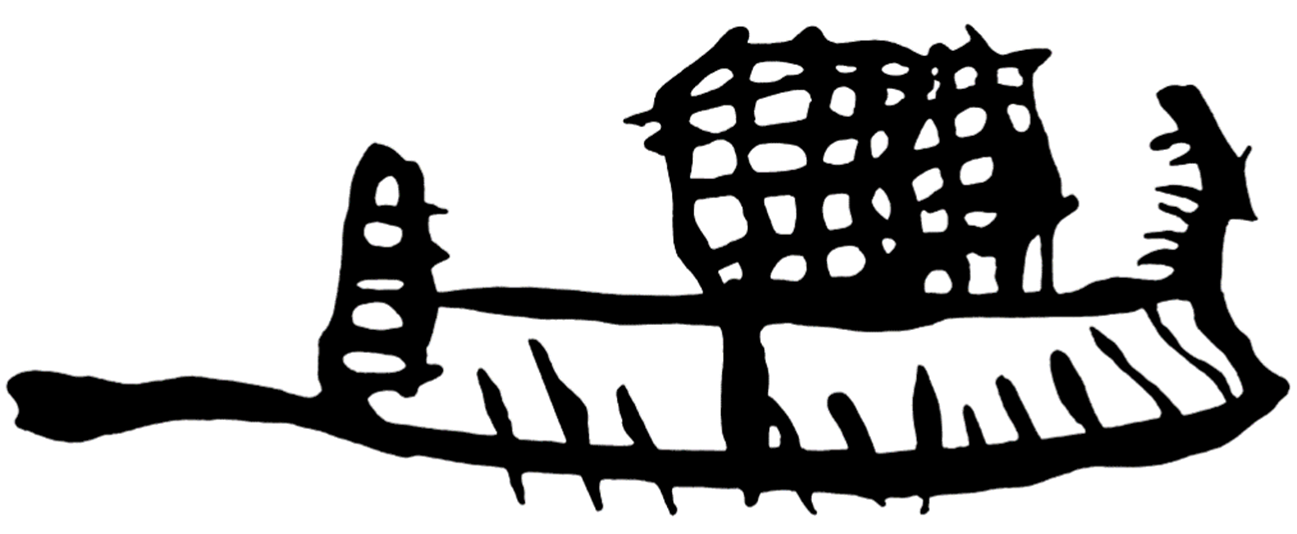Ship to the right with a flat hull and high vertical posts. The keel line curves slightly upwards into a short cutwater. The stempost is S-shaped, terminating in a slightly incurving horn decorated with six vertical strokes on its inner edge. Vertical stern painted as two parallel lines connected by five horizontal posts. This somewhat rectangular structure possibly represents the aftercastle. A horizontal line flaring into a club-like terminal should be understood as the steering-oar. Horizontal line above the keel like is the gunwale, with eleven sub-vertical strokes along the keel line representing oars. The mast is well aft of amidships, with a sail decorated with a net pattern located in front of it. This indicates a construction from a collection of small panels that were sewn together.
Helladic galley
A88
LH IIIC
Asine, House G
H: 8.2 cm; Diameter: 6.5
Miniature stirrup jar. Coarse reddish clay with dull, brown-black paint
Nauplion Archaeological Museum 3319
Bass 1972: 22; Basch 1987: 146-47, fig. 309; Casson 1971: fig. 29; Delivorrias 1987: 156-157, nr 57; Frödin and Persson 1938: 300, nr 2; Kirk 1949: 117-18 (iii); Morrison and Williams 1968: 10, BA 3; Wachsmann 1981: 204-205; 1998: 140; Wedde 2000: no. 641
The ship is schematic enough to cause disagreements as to which side is the bow and which is the stern. Kirk and Williams think the ship faces left, with the long projection on the left representing a ram. Majority opinion however, including Casson, Bass, Basch, Wachsmann, and Wedde, argues that the ship faces right. Some of the considerations that reinforce this hypothesis include: 1) similar observable quarter rudder occasionally strung directly behind the ship on some ship graffiti; 2) if the thick vertical line in the center is a mast, the sail is shown billowing to the right; 3) horizontal projections on the inboard side of the stempost similar to ones painted on the stempost of a contemporaneous askos ship model from Cyprus (Wachsmann 1998: 140). The incurving stempost device could be a predecessor of the typical horn seen on Geometric ships, an observation previously made by Dakoronia (Dakoronia 1990: 118).
Basch, L. 1987. Le musée imaginaire de la marine antique. Athens: Institut Hellénique pour la preservation de la tradition nautique.
Bass, G.F. 1972. A History of Seafaring based on Underwater Archaeology. London: Thames and Hudson.
Casson, L. 1971. Ships and Seamanship in the Ancient World. Princeton: Princeton University Press.
Delivorrias, A. (ed.) 1987. Greece and the Sea. Catalogue of the exhibition organized by: the Greek Ministry of Culture, the Benaki Museum, the National Foundation De Nieuwe Kerk, Amsterdam, in honour of Amsterdam Cultural Capital of Europe 1987. Athens.
Frödin, O. and A. W. Persson 1938. Asine. Results of the Swedish Excavations 1922-1930. Stockholm.
Kirk, G.S. 1949. “Ships on Geometric Vases.” BSA 44: 93-153, pls. 38-40.
Morrison, J.S. and R.T. Williams. 1968. Greek Oared Ships: 900-322 B.C. Cambridge: Cambridge University Press.
Wachsmann, S. 1981. “The Ships of the Sea People,” IJNA 10: 187-220.
―――. 1998. Seagoing Ships & Seamanship in the Bronze Age Levant. College Station, TX: Texas A&M University Press.
Wedde, M. 2000. Towards a Hermeneutics of Aegean Bronze Age Ship Imagery. Peleus Studien zur Archäologie und Geschichte Griechenlands und Zyperns, vol. 6. Bibliopolis: Mannheim and Möhnsee.



